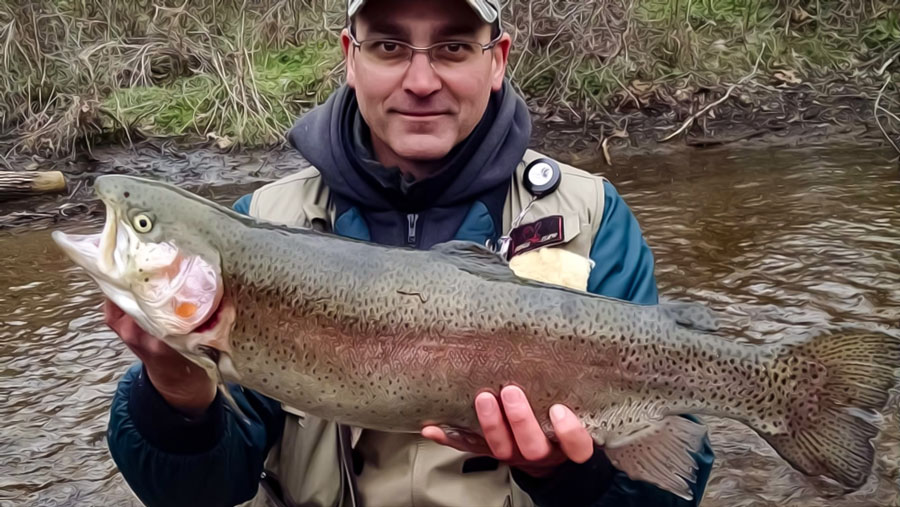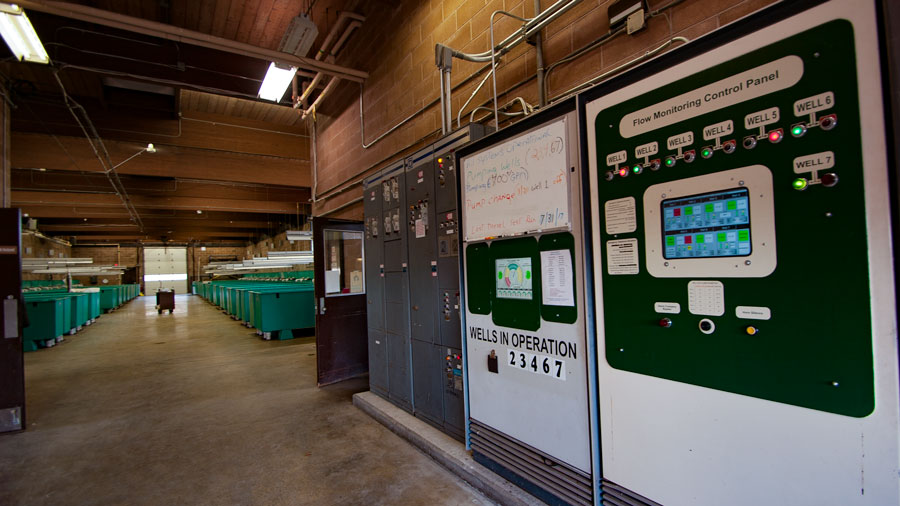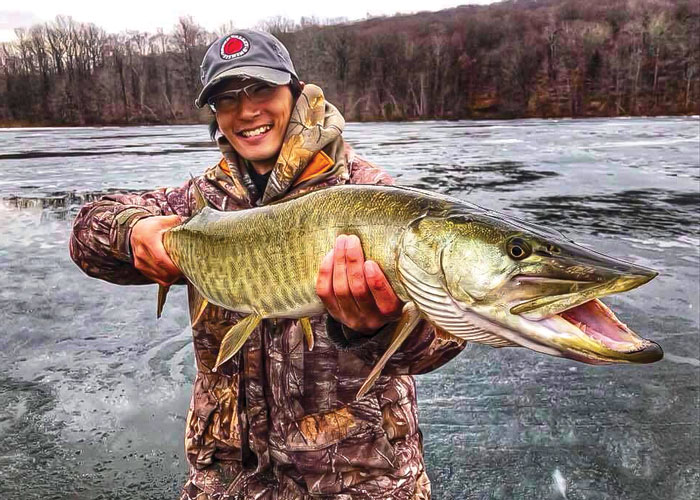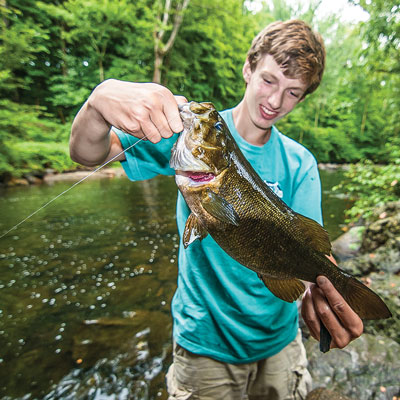For many, the first day of fishing season is also Opening Day of Spring. Early April water is cold, high, and fast, but even the most severe conditions cannot deny dedicated fishers their place streamside on a Saturday morning in early April , when a fresh and feisty generation of stocked rainbow trout become fair game. Six-hundred-thousand of them, to be more precise, each born and bred at the Pequest Trout Hatchery and Natural Resource Education Center which lies on a 5,000-acre state Wildlife Management Area between Route 46 and Pequest Road in Oxford.

The hatchery is open year-round for visitation, although the best time to see the actual fish-raising operation is from October through May, when the nursery building is open. In the fall, eggs taken from breeders hatch into larvae that are brought into the nursery in yolk as sac fry, where the juvenile rainbows are nurtured until spring, when they move to the outdoor raceways for a year of growth before entry into the waterways of New Jersey.


The Pequest facility also includes a Natural Resource Education Center for environmental education, where visitors develop the behaviors and skills necessary to become stewards of wildlife and natural resources through programs for families, scouts and other groups. The annual Open House and Fisherman’s Flea Market is the perfect tune-up for fishing season, with all kinds of outdoor activities, demonstrations and instruction.
Pequest began operations in 1981, when trout production was transferred from the Charles O. Hayford Hatchery in Hackettstown, the only other state-run hatchery in New Jersey. With the exception of those grown by private facilities, every stocked fish in the state was born and raised in clean, fresh water from Warren County ground. At Hackettstown, that water flows directly from underground springs at the rate of 1300 gallons per minute to support the growth of over five million fish (a record number in 2017) each year, including northern pike, walleye, muskellunge, channel catfish, largemouth bass, and hybrid striped bass. “We’ve even supplied six neighboring states with fish, including New York which has thirteen hatcheries of their own,” explains hatchery superintendent Craig Lemon. “All our current programs began with eggs from New York and Pennsylvania, so we’re giving back now.” The hatchery also sends northern pike to Massachusetts, while they have provided landlocked salmon for an exciting new venture. “We quit stocking lake trout because natural reproduction had taken over so we had some room and started bring the salmon back here to raise bigger to fourteen inches,” says Lemon. “As soon as we started stocking them, the anglers started catching them.” Warren County anglers can now hunt salmon averaging eighteen inches in Tilcon Lake, near the Musconetcong River at Waterloo Village, and perhaps Merrill Creek Reservoir later this year.

Merrill Creek, the county’s largest impoundment, which reaches depths of two-hundred feet, already contains an impressive population of finned monsters, including the deep-running gigantic lake trout, big brown trout, largemouth and smallmouth bass. Two of Warren County’s smaller lakes — Furnace Lake in Oxford and Mountain Lake in Liberty Township — are home to an outsized number of outsized trophy fish. Last year, the hatchery stuffed Furnace with thousands of channel catfish, muskellunge and tiger muskies (a hybrid of true muskellunge and northern pike that grow quickly to weights approaching thirty pounds). For prize largemouth bass, Delaware Lake in Knowlton Township is one of only three lakes in the state designated as “lunker bass lakes”, where there a fifteen-inch minimum size regulation assures the availability of more quality-sized fish.

Ron Jacobson has worked at the Hackettstown Hatchery for fifteen years. It’s his retirement job and, since he’s loved to fish all his life, a wish come true. Muskellunge, however, was one fish he had no experience with until recently. The hatchery works closely in developing and protecting local fisheries with New Jersey Chapter 22 of Muskies, Inc., the national organization that works to improve the sport of catching—and releasing— this largest, and relatively uncommon, member of the pike family of fish. Ron remembers, “To thank us for the work we do, they took some of us from the hatchery out in two groups to Furnace and Mountain Lakes. I went to Mountain and cast a huge lure for 3 ½ hours until my arm was just about worn out. Finally I got a strike that almost pulled me out of the boat. That turned out to be the one and only Musky I’ve ever caught in my life — forty-four inches long!”
Muskie tackle is specialized; lures can cost $30-40 each, and the rigs are heavy duty. Muskie and their hybrid tiger muskie cousins have been called the fish of 10,000 casts due to the patience and determination required to catch them. But the challenge to land such large and ferocious game is irresistible to most fishermen. “People think they see alligators out there,” says Ron. “They kind of float on top of the water, just swimming with their mouths open. They’ll eat baby ducks and geese.”
Warren County is flanked by the river valleys of the Musconetcong and Delaware, and traversed by the Paulins Kill and Pequest. These, along with dozens of streaming tributaries, offer fishers endless delights, although some prefer the solitude of spring fly fishing along a handful of tiny creeks designated as wild trout waters. Besides the nimble rainbow, plenty brookies and browns still swim those big rivers which flow through a progression from rugged terrain to the north and west to the gentle farmland of the east and south. The scene on opening day is trout fishing mayhem, but the occasional falls along the inland rivers become serene as the season progresses and you are more likely to find yourself alone. Natural bait, artificial flies and lures catch fish year round. You can always count on a persistent rock bass or sunfish to rise on a fly or two when the trout aren’t interested.

Our 2014 family vacation on Long Pond, Mount Desert Island, Maine, seemed to promise better smallmouth bass than any my son and I had caught, but although we paddled and cast likely locations along the lake’s seven-mile length, no bass weighed more than any we had caught in New Jersey during previous summers. We returned home to Bedminster. The next day I took Matt to the Paulins Kill in Warren County. The irony! Where we fished, the river’s flow pulses with little more power than a creek. Both of us broke records here in our home state instead of in Maine. My bass weighed about an ounce more than four pounds. Matt’s, about three-and-a-half, perhaps slightly heavier than a smallmouth he had caught on Lake Hopatcong.
The month of August is always productive for smallmouths, although we have not always caught big ones. But in the Paulins Kill we’ve encountered bass we didn’t hook, estimated bigger than any we’ve bank-sided yet.
During the spring and early summer, the river fishes well for trout. Our experience includes only one brown trout some years ago, caught on a fly rod, though I’ve caught dozens of rainbow trout on salmon eggs in Warren County’s Pequest River. A friend, Mike Maxwell, has fished a Paulins Kill spot near road access during April with an ultra-light spinning outfit and salmon eggs, catching many rainbows.
Further adventure awaits on the Delaware River, where anglers find more bass, walleye, catfish and muskellunge — only usually bigger — along with monster carp. And, believe it or not, eels make their way up the Delaware from the Atlantic Ocean, many times well up into the Paulins Kill and Musconetcong. But the Delaware’s kindest gift from the ocean is shad, when each spring millions of fish enter the Delaware Bay to begin the long and arduous upstream swim to their fresh water origins where they will spawn. Since shad do not eat during their migration, no one knows why they strike lures floated in their midst. But strike they do, much to the delight to a growing number of sport shad enthusiasts. These strong salty soldiers offer some of the best battles on the river, especially on light tackle. The growing abundance of shad in spring reminds us again how fortunate we are to have in our midst the largest free flowing river in the East, one that has eagerly responded to conservation and clean up efforts. Shad have also recently been spied in the Musconetcong, where dam removal has cleared their path through the ripe riffles of spring. With the projected removal on the Columbia dam on the Paulins Kill, there too the shadow of a shad may soon be a common sight. More shad...
Consider Rutherfurd Hall as refuge and sanctuary in similar ways now, as it served a distinguished family a hundred years ago.

A fine art gallery like no other! Unique, handmade gifts and cards as well as yoga, meditation, and continued learning lectures. Come in Saturdays for all-day open mic and Sundays to try unique nootropic chocolate or mushroom coffee. Browse the $5 books in the Believe Book Nook while you nibble and sip.
Millbrook Village, part of the Delaware Water Gap National Recreation Area, is a re-created community of the 1800s where aspects of pioneer life are exhibited and occasionally demonstrated by skilled and dedicated docents throughout the village
Choose and Cut from 10,000 trees! Blue Spruce, Norway Spruce, White Pine, Scotch Pine Fraser Fir, Canaan fir, Douglas Fir. Family run on preserved farmland. Open Nov 29 - Dec 23, Tues-Sunday, 9-4. Easy Access from Routes 78 or 80.
The 8,461 acre park includes the 2500-acre Deer Lake Park, Waterloo Village, mountain bike and horseback trails.